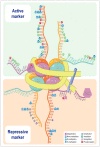Altered histone modifications in gliomas
- PMID: 24926467
- PMCID: PMC4049557
- DOI: 10.14791/btrt.2014.2.1.7
Altered histone modifications in gliomas
Abstract
Gliomas are the most frequently occurring primary brain tumors in adults. Although they exist in different malignant stages, including histologically benign forms and highly aggressive states, most gliomas are clinically challenging for neuro-oncologists because of their infiltrative growth patterns and inherent relapse tendency with increased malignancy. Once this disease reaches the glioblastoma multiforme stage, the prognosis of patients is dismal: median survival time is 15 months. Extensive genetic analyses of glial tumors have revealed a variety of deregulated genetic pathways involved in DNA repair, apoptosis, cell migration/adhesion, and cell cycle. Recently, it has become evident that epigenetic alterations may also be an important factor for glioma genesis. Of epigenetic marks, histone modification is a key mark that regulates gene expression and thus modulates a wide range of cellular processes. In this review, I discuss the neuro-oncological significance of altered histone modifications and modifiers in glioma patients while briefly overviewing the biological roles of histone modifications.
Keywords: Acetylation; Epigenetics; Glioblastoma; Glioma; Histone; Methylation.
Conflict of interest statement
The author has no financial conflicts of interest.
Figures






Similar articles
-
Beyond Genetics in Glioma Pathways: The Ever-Increasing Crosstalk between Epigenomic and Genomic Events.J Signal Transduct. 2012;2012:519807. doi: 10.1155/2012/519807. Epub 2012 Jun 18. J Signal Transduct. 2012. PMID: 22778947 Free PMC article.
-
Epigenetic aberrations in malignant gliomas: an open door leading to better understanding and treatment.Epigenetics. 2007 Jul-Sep;2(3):147-50. doi: 10.4161/epi.2.3.5049. Epub 2007 Sep 15. Epigenetics. 2007. PMID: 18063907 Review.
-
Targeting post-translational histone modifying enzymes in glioblastoma.Pharmacol Ther. 2021 Apr;220:107721. doi: 10.1016/j.pharmthera.2020.107721. Epub 2020 Nov 2. Pharmacol Ther. 2021. PMID: 33144118 Review.
-
Histone deacetylase inhibitors exert anti-tumor effects on human adherent and stem-like glioma cells.Clin Epigenetics. 2019 Jan 17;11(1):11. doi: 10.1186/s13148-018-0598-5. Clin Epigenetics. 2019. PMID: 30654849 Free PMC article.
-
Glioma epigenetics: From subclassification to novel treatment options.Semin Cancer Biol. 2018 Aug;51:50-58. doi: 10.1016/j.semcancer.2017.11.010. Epub 2017 Nov 21. Semin Cancer Biol. 2018. PMID: 29170066 Review.
Cited by
-
MiR-101 reverses the hypomethylation of the LMO3 promoter in glioma cells.Oncotarget. 2015 Apr 10;6(10):7930-43. doi: 10.18632/oncotarget.3181. Oncotarget. 2015. PMID: 25829251 Free PMC article.
-
The Role of Non-Coding RNAs in Epigenetic Dysregulation in Glioblastoma Development.Int J Mol Sci. 2023 Nov 14;24(22):16320. doi: 10.3390/ijms242216320. Int J Mol Sci. 2023. PMID: 38003512 Free PMC article. Review.
-
Long non-coding RNAs in brain tumours: Focus on recent epigenetic findings in glioma.J Cell Mol Med. 2018 Oct;22(10):4597-4610. doi: 10.1111/jcmm.13781. Epub 2018 Aug 17. J Cell Mol Med. 2018. PMID: 30117678 Free PMC article. Review.
-
Single-cell RNA sequencing of mitotic-arrested prospermatogonia with DAZL::GFP chickens and revealing unique epigenetic reprogramming of chickens.J Anim Sci Biotechnol. 2022 Jun 6;13(1):64. doi: 10.1186/s40104-022-00712-4. J Anim Sci Biotechnol. 2022. PMID: 35659766 Free PMC article.
-
The Mitochondrial Protein VDAC1 at the Crossroads of Cancer Cell Metabolism: The Epigenetic Link.Cancers (Basel). 2020 Apr 22;12(4):1031. doi: 10.3390/cancers12041031. Cancers (Basel). 2020. PMID: 32331482 Free PMC article.
References
-
- Clark SJ, Harrison J, Frommer M. CpNpG methylation in mammalian cells. Nat Genet. 1995;10:20–27. - PubMed
-
- Okano M, Xie S, Li E. Cloning and characterization of a family of novel mammalian DNA (cytosine-5) methyltransferases. Nat Genet. 1998;19:219–220. - PubMed
-
- Li E, Beard C, Jaenisch R. Role for DNA methylation in genomic imprinting. Nature. 1993;366:362–365. - PubMed
-
- Eden A, Gaudet F, Waghmare A, Jaenisch R. Chromosomal instability and tumors promoted by DNA hypomethylation. Science. 2003;300:455. - PubMed
Publication types
LinkOut - more resources
Full Text Sources
Other Literature Sources

